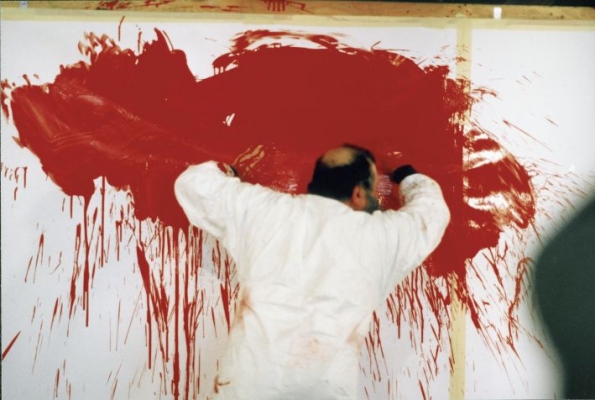In the 1960s, Hermann Nitsch (1938), together with Günter Brus, Otto Muehl and Rudolf Schwarzkogler, formed one of the most radical 20th century art movements, which became known in art history as Viennese Actionism. As his life’s work he sees the Orgies Mysteries Theatre (Das Orgien-Mysterien-Theater), an intense artistic experience bringing together painting, theatre, music and lyrics with liturgical, religious elements, which was established in the late 1950s.
The Orgies Mysteries Theatre is based on the idea of creating something that exceeds a theatre production, and Hermann Nitsch believes that is only possible when both viewer and actor are involved and transformed to an equal extent. In a sense, it is art therapy, at which the Viennese Actionists arrived by gradually studying the works of Sigmund Freud and Wilhelm Reich. The Orgies Mysteries Theatre does not submit to passive observation and neutrality, in the words of Otto Muehl: “Our action was not only a form of art, but, above all, an existential attitude.”
The venue of the exhibition, the Museum of Decorative Arts and Design (MDAD), which is housed in the former St. George’s Church and is the oldest preserved stone structure in Riga (built in 1204), is not coincidental, as recreation of Christian rituals is one of the most important elements of the artist’s oeuvre. Thus, the building itself becomes an essential part of the exhibition, joining together key points in Nitsch’s creative output. The exposition includes the most significant of Hermann Nitsch’s artistic rituals – documentary video from the actions of his Orgies Mysteries Theatre with culmination in the action 6-Day-Play, examples of action painting, large-format graphic art and documentary photographs.
The Orgies Mysteries Theatre is the first exhibition of Hermann Nitsch’s work in the Baltic States, making it a unique opportunity to get to know the author who has left a significant mark not only on the fields of action painting and performance, but also the development of contemporary theatre.
The exhibition is complemented by an essay booklet, to which Hermann Nitsch, Igor Gubenko, Laine Kristberga, Vilnis Štrams and Līna Birzaka-Priekule have dedicated their texts, as well as an audio guide in Latvian and English.
The exhibition is accompanied by an educational programme including conversations with the artist, a cycle of discussions and talks, performances and activities for young visitors. For example, on 16 October at 14.00 in Dome Square (Doma laukums) there will be a performance by artist Anda Lāce, titled Difficult to Tell Whether It Is Hypocrisy of Orgiastic Proportions or Has Everyone Here Indeed Suddenly Become Better, made in collaboration with composer Evija Skuķe. The artist will reflect on and confront herself with the conceptual impulses provided by Hermann Nitsch, over the course of her performance creating a processual painting object. Anda Lāce is interested in the ritual aspect of Nitsch’s work and the way his performative expressions create permanent works of art retaining powerful energy from the action which has already taken place.
Hermann Nitsch is an Austrian avant-garde artist, one of the Viennese Actionists. In their rituals (actions) the representatives of this artistic movement often use self-mutilated bodies, defilement, animal entrails, urine, faeces, blood as means of expression to demonstrate a subconscious reaction against Austria’s ‘whitewashing’ of its crimes, participation in National Socialism and the Holocaust.
Hermann Nitsch lives and works in Prinzendorf Castle, which hosted the legendary action 6-Day-Play (1998). A museum dedicated to Nitsch is located in the Austrian town of Mistelbach. The author’s works are in the collections of the Museum of Modern Art in New York, Tate Gallery in London and many others.
Text by Līna Birzaka-Priekule




